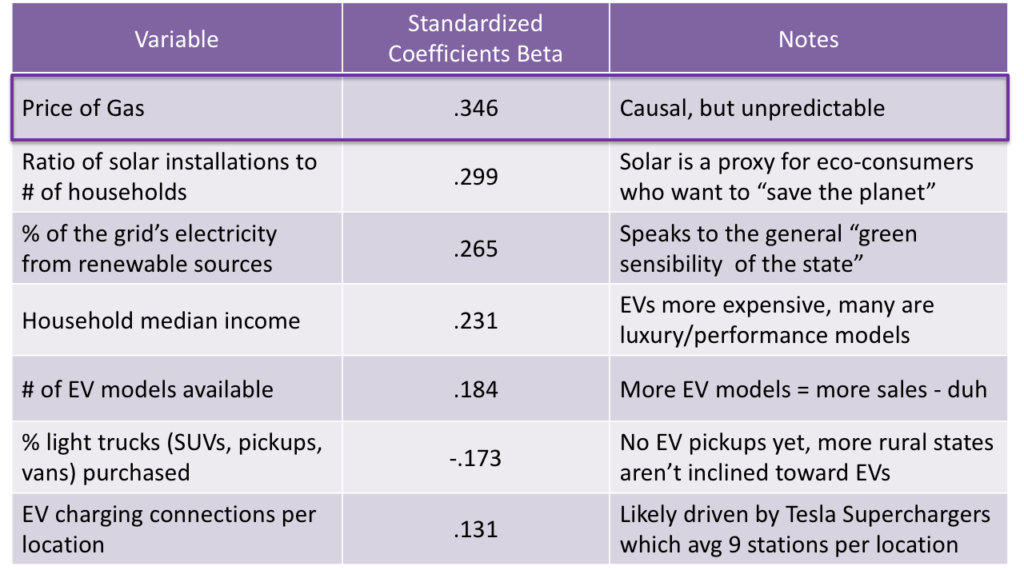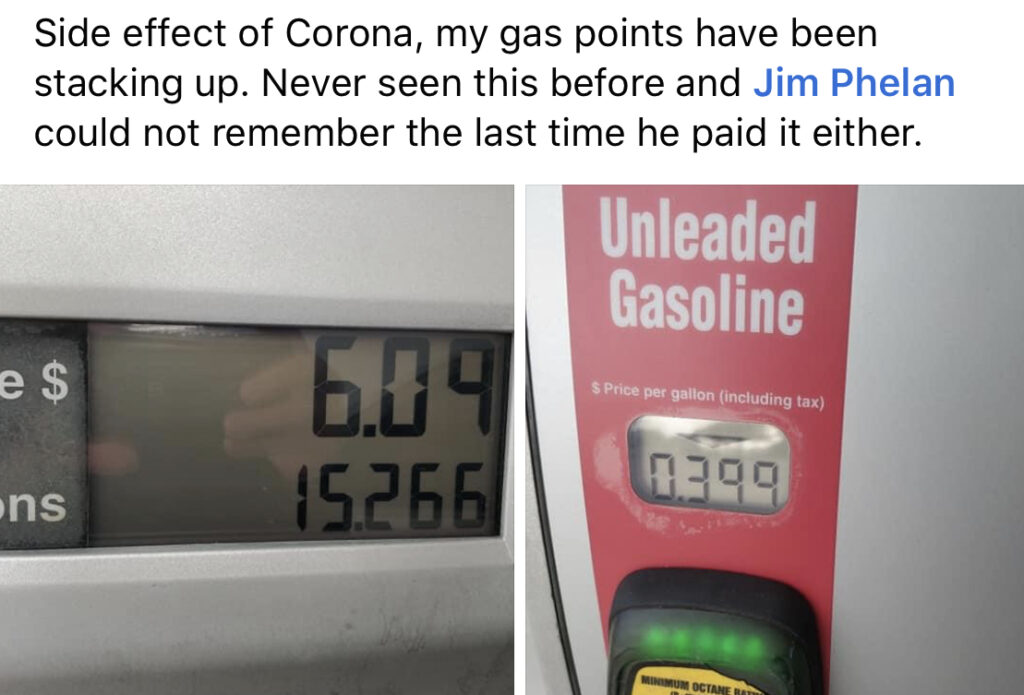The COVID-19 pandemic and its impact on supply chains and consumer spending will have a negative effect on electric vehicle sales in the US, likely for the next 12-18 months. But a potential double whammy impact on EV sales is the lowest gas prices that many regions have seen in the last decade or more.
Twice over the last four years I’ve used regression analysis and looked at more than 30 different variables to try and understand which factors have the highest correlation with EV sales by US state. In both analyses, gas prices had the highest correlation with state-by-state sales, and right now unfortunately for the EV industry, gas prices are now at their lowest points in several years.

Now as many observers might point out, correlation does not always equal causation. But I strongly believe that high gas prices motivate car buyers at a higher rate to consider more fuel-efficient alternatives to regular gas vehicles – whether hybrid, plug-in hybrid (PHEV) or full battery electric vehicle (BEV).
The relationship between gasoline prices and the demand for automobiles was the subject of several economic studies in the 1980s in the aftermath of the gasoline price shocks of the 1970s. Those studies found that higher gasoline prices increased the demand for smaller, more-fuel-efficient vehicles relative to larger, less-efficient vehicles.
Current gasoline prices and the market shares of specific types of vehicles should be related to the extent that current prices influence consumers’ expectations about future prices and to the extent that vehicle operating costs (primarily fuel costs) influence consumers’ decisions about which vehicles to purchase.
Congressional Budget Office (CBO), Gas Prices and Vehicle Markets
The Congressional Budget Office (CBO) explains that consumers apply a concept known as “static expectations” – the assumption that people expect the value of an economic variable next period to be equal to the current value of this variable. With the US economy likely headed for a recession and the longer-term impact of the shelter-in-place orders, a typical consumer likely believes that gasoline prices will remain at current levels – or even decline further – over the next 12-24 months.
Current US Gas Prices At 10 Year Low
Using data from GasBuddy, the average price per gallon of gasoline in the US was roughly $1.74 on April 25, 2020, a decline of $0.79 or 31% since January 25. Gas prices fell quickly and deeply due to the massive decline in demand and a huge oversupply, with oil producers even running out of facilities to store production.
The current price per gallon is the lowest US average in the last 10 years. California, which accounts for nearly 50% of US EV sales, is seeing average gas prices of roughly $2.70, its lowest average since 2016.
The Impact on Potential Gas Savings Comparisons
While there are many reasons to purchase an electric vehicle over a gas-powered car or truck, electric vehicle’s lower cost to “fuel” its motor(s) is often a top factor cited by EV advocates. And Tesla, though often derided for this practice, lists potential gas savings costs on its website for each vehicle.
But, and not to pick on Tesla, the comparative gas savings for a Model 3 of $4,300 (in this example for the period of a 72-month loan), is based on $2.85 per gallon price of gas and 15,000 miles per year (according to the Los Angeles Times). At $1.75 per gallon, the 7-year savings using Tesla’s assumptions, would be around $2,650, or about $375 per year.
Tesla says it bases the “gas savings” on a putative customer’s average annual driving mileage of up to 15,000 miles a year, a gas price of $2.85 per gallon, and fuel economy of 28 miles per gallon for a car similar to a BMW 3 series. The company assumes an average electricity cost of 13 cents per kilowatt-hour to charge its vehicles.
Los Angeles Times
Now $375 per year, or savings of roughly a dollar per day for 7 years is not nothing, but if you only drive say 10,000-12,000 miles per year and your comparison gas vehicle gets say 35-40 MPG, then the potential gas savings is probably close to zero.
But all of this math and these calculations with spreadsheets is lost on the average consumer who more than likely just looks at the price of gas at the pump and smacks their head.

Possible Impact On Electric Vehicle Sales
To be clear, not all industry analysts agree that low gas prices have a negative effect on electric vehicle sales. And there are multiple factors that can cloud the potential impact of low or high gas prices, most notably the introduction of new higher-volume EVs.
In 2020 and 2021, however, the two factors likely to have the biggest impact on electric vehicle sales in the US are:
The economy and COVID-19 recovery: According to the National Automobile Dealers Association (NADA), auto sales overall were down 12.7% in Q1 2020 versus 2019, but March saw a 37.9% decline versus March 2019. NADA now estimates new light-vehicle sales between 13 million and 13.5 million units for the year – down from an original 2020 sales forecast of 16.8 million units.
New “higher-volume” EV models: Since 2011, the primary factor that drove a YOY increase in EV sales was the introduction of new “higher volume” (1,000+ units sold per month) EV models such as the Tesla Model S and X, Chevrolet Bolt, and Honda Clarity PHEV, and updated Toyota Prius Prime.
In 2020 and 2021 models that should see strong sales include the Tesla Model Y, Ford Mustang Mach-E, and VW ID.4. These new models should be additive to overall EV sales, though at a lower volume than previously expected.
In the coming years we won’t ever truly know what impact lower gas prices had on EV sales, but perhaps the best gauge will be to track sales of vehicle models that offer multiple powertrain options. If there is a significant shift among the the powertrain options to higher unit sales of the gas or regular hybrid versions, we might be able to attribute some of this shift to the lower price of gasoline. These include:
- Kia Niro
- Toyota RAV4
- Hyundai IONIQ
- Ford Fusion
With overall US auto sales expected to be down 20%-25% compared to 2019, electric vehicle sales should be down perhaps 15% to 20% versus previous 2020 forecasts. And while most of the lower than expected EV sales will be due to factors from the COVID-19 pandemic, sustained lower gas prices will provide an additional reason for some consumers to opt for a gas vehicle or prolong entirely a planned purchase of an electric vehicle.
 Announcing the acquisition of EVAdoption by Paren →
Announcing the acquisition of EVAdoption by Paren →

4 Responses